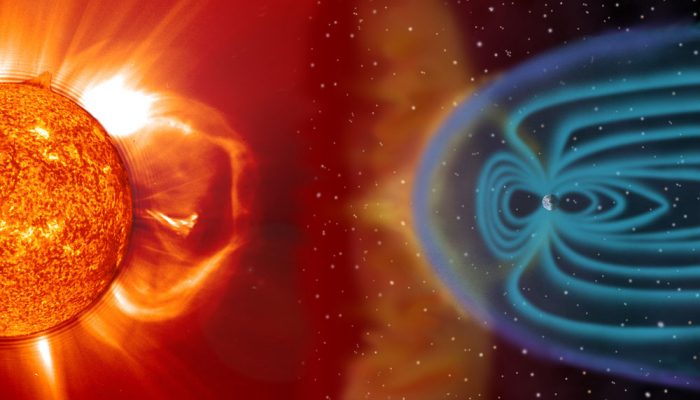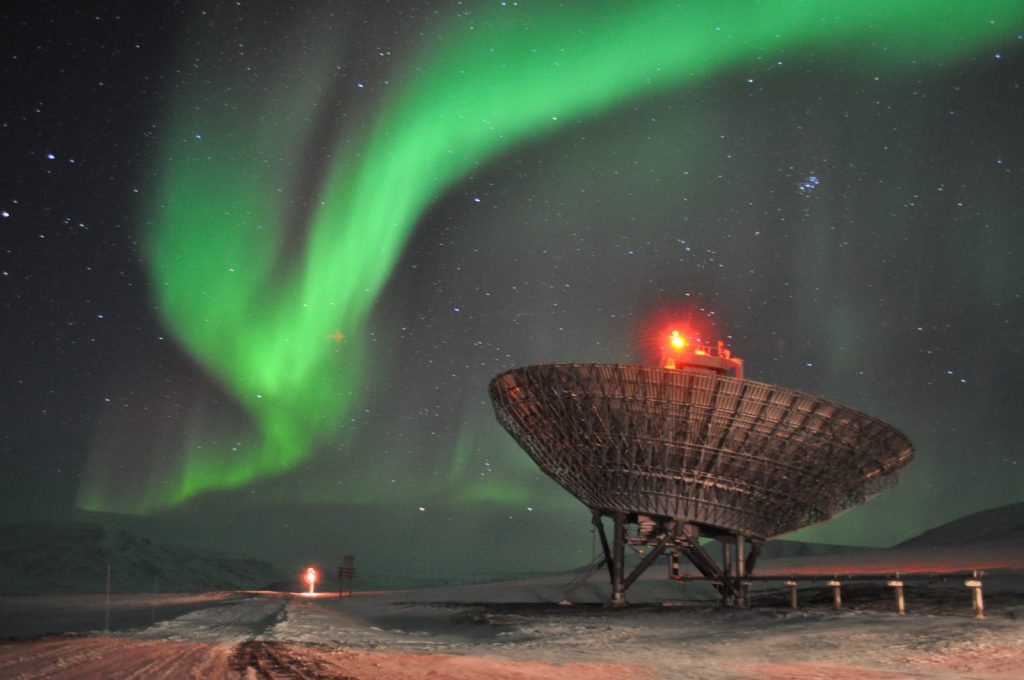
Our closest star, the Sun, is constantly emitting hot gas in all directions as its upper atmosphere, the corona, expands. This is known as the Solar Wind, also carrying with it an embedded magnetic field, the Interplanetary Magnetic Field (IMF). The IMF originates at the Sun and forms an enormous spiral throughout the solar system as the solar wind escapes radially, while the magnetic field-lines are anchored to the rotating Sun. This is the large-scale environment, or the laboratory, for a magnetospheric physicist. The core of magnetospheric physics is to increase our understanding of the complex interactions occurring when a magnetized planet is exposed to this solar wind and IMF environment. This blog-post will briefly mention some of the ways we study this interaction, and what kind of questions we try to answer about the solar wind – magnetosphere system.
First of all, what is a magnetosphere? A magnetosphere is the region around a magnetized planet where the magnetic field is the one related to the planet itself. The other magnetic domain is the one only connected to the Sun or solar wind, referred to as the IMF in this context. As for the Earth, the boundary between the Earth’s magnetic field and the IMF field-lines is rather sharp. On the dayside, this boundary, known as the magnetopause, usually sits at about ~10 Earth radii toward the Sun at the subsolar location, and wrap around to form a blunt surface that define the magnetosphere, as seen in the image above, forming a long tail in the anti-sunward direction.
When the solar wind and the IMF interact with the magnetosphere a variety of processes take place. Most interesting – when it comes to energy and momentum transfer into the magnetosphere system – is the magnetic interactions, initially taking place at the dayside magnetopause. Through a process known as magnetic reconnection, field-lines initially connected only to the planet can merge with the incoming IMF to form field-lines magnetically coupled both to the planet and to the Sun/solar wind. This allows these newly opened field-lines to be pulled tailward by the solar wind, while still being anchored to the Earth. This is how most of the solar wind energy enter the magnetosphere system, which could reach values of Terra Watts during geomagnetic storms. A consequence of the dayside reconnection process is that the reservoir of field-lines connected only to Earth is continually reduced. The magnetosphere’s way of solving this problem is through creating new field-lines that have both their footprints anchored to the planet, again through the process of magnetic reconnection. This happens deep within the magnetotail, and causes momentum and energy to be transported toward the planet, responsible for a variety of phenomenon that we can see and measure on the ground at Earth. Most notable are the aurora borealis and -australis visible in bands around the magnetic poles, and associated magnetic disturbances. Interestingly, the entry of the solar wind plasma (particles) itself into the magnetosphere is not very important in describing the aurora. The accelerated particles causing the aurora largely originate from within the system although their energy come from the solar wind.
When studying the magnetosphere, a large variety of instruments are being used. One can distinguish between two types of measurements that complement each other, to a large degree. To measure the influence from a large region of the mangetosphere simultaneously, remote sensing techniques are applied. One example of such is observations of the aurora, where the light originate from the high latitude ionosphere at typically 100-200 km. Since the magnetic field at high latitudes map out to very large regions of the magnetosphere, the aurora can be interpreted, to some extent , as a screen illuminating the more distant magnetospheric processes. Therefore, by studying the high-latitude electrodynamics close to the ground, one can infer properties of the much larger magnetosphere. The other type of measurements is in-situ observations of physical quantities such as electric and magnetic fields/waves and charged or neutral particles. This is usually obtained from satellites orbiting within the magnetosphere. One major challenge when interpreting such data in terms of the big system is that they only provide point measurements in a huge system. Also, temporal and spatial variations are in general mixed, as stationary is difficult to obtain/determine. Hence, remote-sensing and in-situ measurements addresses different spatial scales and often different processes in the magnetosphere system, and act complementary to each other in order to obtain increased knowledge of how the system works. Recent missions that has greatly contributed to increase the understanding of the solar wind – magnetosphere – ionosphere interactions include Cluster, THEMIS, Swarm, Van-Allen Probes, and MMS.
Although we have learned a lot, especially through the space age, of how the solar wind and IMF environment affect the mangetosphere, many questions still remain. One example is the very nature of the reconnection process, which is a fundamental plasma process allowing efficient energy transfer into the system. A dedicated mission, the Mangetospheric Multiscale Mission was recently launched to investigate its details by probing the reconnection region at finer spatial scales than ever before by 4 closely separated spacecrafts. At present, most models describing the large-scale distributions of the important parameters in our system are indeed very static. We know that the reality is highly dynamic and structured, and it remains as an outstanding challenge to further enhance our understanding of the complexities in our system to be able to more accurately predict the outcome of the solar wind – magnetosphere – ionosphere interactions.

